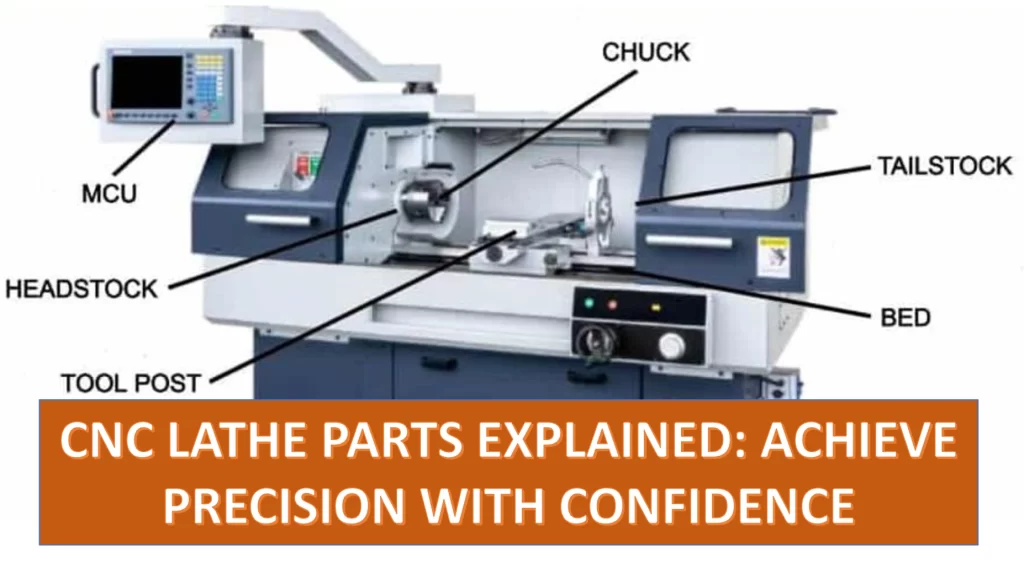
CNC Lathe Parts
A CNC lathe, which is also referred to as a CNC turning machine, is a highly precise and automated equipment used for manufacturing CNC turning parts. The full name is Computer Numerical Control (CNC) lathe machine, so it gets its instructions from a computer program.
You will get the most advanced forms of this machine at Prolean Tech, a company that is synonymous with complex and precise CNC turning among other lathe processes.
It is no wonder this highly-regarded firm capable of producing parts within one day has various international certifications, including ISO 9001:2015, ISO 13485, and IATF 16949:2016.
A CNC lathe uses various operations and tools to produce a variety of components. CNC programs are at the heart of these operations, but CNC lathe parts do the core work. The machine bed provides stability, the carriage moves the cutting tool, the chuck holds the workpiece, and the headstock holds and rotates the workpiece.
There are several other CNC lathe machine components such as the control panel, servo motor, and CNC controller. As you look for the best CNC machined components, it is worthwhile to know more about the lathe machine and parts.
In this article, we take a deep dive into the different CNC lathe parts.
What is CNC lathe: Prolean Tech’s Modern Machining Solutions for Businesses
A CNC lathe is a versatile machine used to produce CNC turning parts for aerospace, automotive, healthcare, agriculture, and many other industries. It manufactures a wide range of parts for industrial use, from surgical instruments for hospitals to gears used in cars.
The versatility of the turning process, milling process, and other capabilities of the CNC lathe is evidenced by the numerous types of features it can manufacture. Some popular CNC lathe features are threads, recesses, splines, and inner/outer diameters.
The CNC lathe is programmed through M-codes and G-codes, which enhance the interaction between the computer control and the tangible machine functions. The machine can use several tools, spindle speeds, and tool feeds to create a wide range of CNC machining results.
As technology advances, the CNC lathe continues to transform. As a result, the modern machine is markedly different from the conventional one with many applications and benefits. You can check here to Learn About Precision Turning Applications & Benefits.
Try Prolean Now!
What is the function of the CNC lathe?
The function of the CNC lathe is to perform a variety of hi-tech machining processes to manufacture important CNC turning parts and components for different industries. This machine is designed to cut, shape, and deform workpieces through subtractive manufacturing.
The lathe comes with unique attachments that make the processes possible. With all the adjustments possible, the CNC lathe is extremely versatile. It is a mechanical device that can manufacture parts to precise details.
The most fundamental CNC lathe operations are as follows:
Cutting
This operation entails separating sizable pieces of material from the main workpiece. The machine uses a sharp cutting tool to execute this operation.
Facing
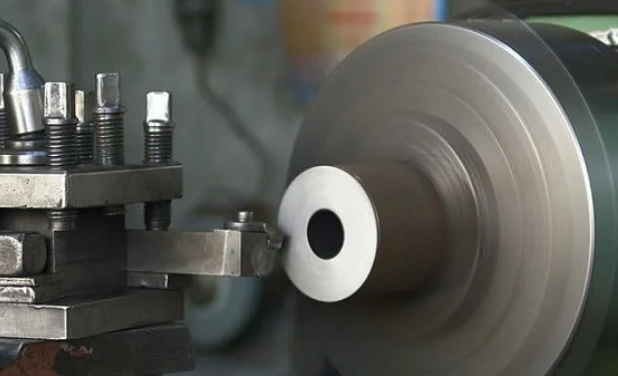
A CNC Face-Turning Process
During general machining, the workpiece is slightly longer than the envisaged size. Facing entails cutting the end of the workpiece perpendicular to the rotational axis. During this operation, the cutting tool removes thin layers of material at the end until the desired length and surface finish is achieved.
Grooving
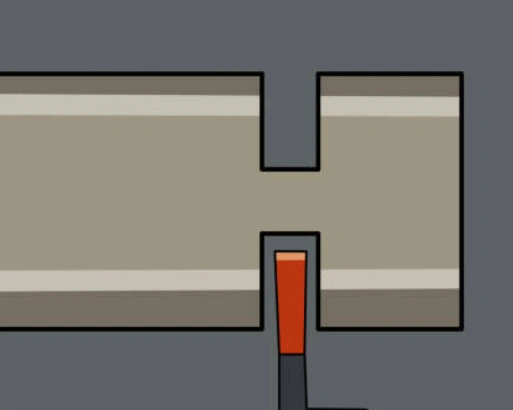
A grooving machining process
In this CNC operation, the goal is to create a narrow groove in the workpiece. Initially, a tool creates a groove that is equal to its width. However, you can still machine a wide groove with several passes.
A groove can be either face or external. An external groove is formed when the cutting tool machines in the radial direction of the workpiece. For face grooving, the cutting tool removes material from the workpiece’s face.
Threading
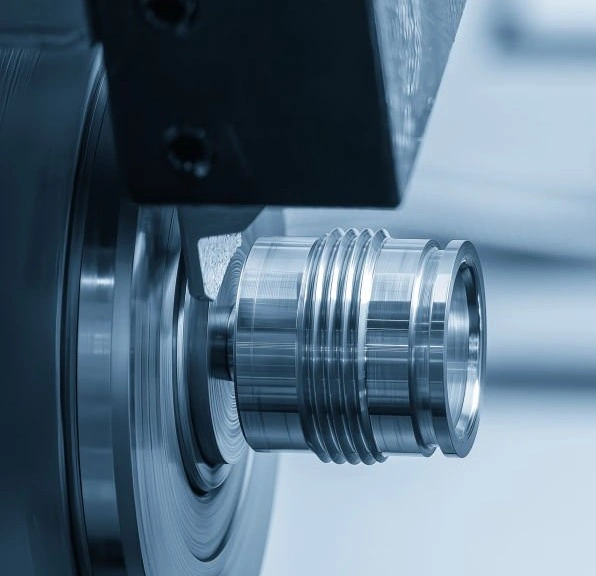
A threaded part
CNC machining can also make threads in this operation called threading. The turning tool machines across the outer surface of the workpiece as it forms threads.
The helical grooves that define the thread are of a specified pitch and length. The cutting tool can make several passes depending on the required thread depth.
Drilling
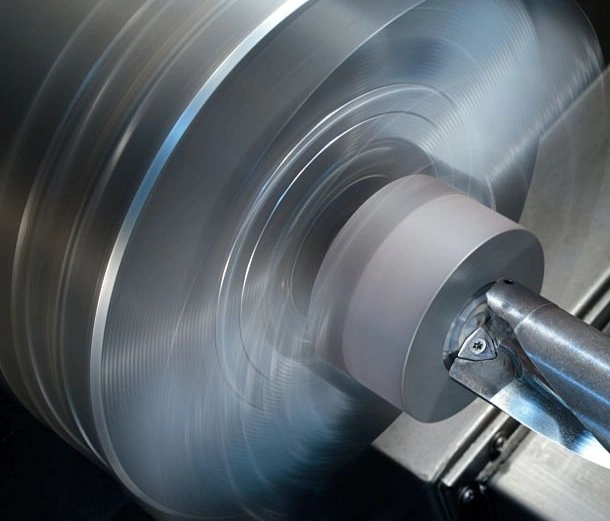
A drilling process
This is a CNC lathe machining operation that removes material from within the workpiece. The machine uses a drill to generate a hole of a specified diameter in the workpiece. The workpiece rotates as the drill is held by a lathe tool holder or tailstock.
Knurling
The serrated patterns on the surfaces of machined workpieces are generated through the knurling process. These patterns serve both aesthetic and ergonomic functions. They enhance the grip on handles.
The knurling operation is performed using a knurling tool, which has teeth that form the patterns when pressed hard against the surface of the workpiece.
There are more of these CNC turning processes at ProleanTech. We have the most comprehensive CNC turning service solutions, and we are sure you would like to sample them.
Try Prolean Now!
How does a CNC lathe work?
The working of a CNC lathe is fascinating as it is handy in producing parts for automotive, military, agriculture, and aerospace, among many other industries. Virtually every business uses CNC lathe machined parts along its supply chain.
The process is straightforward, but only a well-organized, experienced, and equipped firm like Prolean Tech is capable of meeting the diverse clients’ requirements consistently.
The Basic Process
A CNC lathe performs the various operations described above using computerized control. The machine has software, which translates design inputs into precise operations.
First, the machinist attaches the workpiece to the spindle. The machining parameters are then set and the machine is started. As the workpiece rotates, the cutting tool on the carriage or tool turret removes material radially or longitudinally.
The CNC lathe has a powerful feedback mechanism that ensures the machining process proceeds as designed. The automated machining process results in accurate components with good surface finish.
For more on how the CNC lathe works, Explore CNC Turning Process & Design Tips here.
The CNC Programming Aspect
For optimal results from the CNC lathe parts, mastery of CNC programming is crucial. The CNC lathe uses two main languages called M-code and G-code. Each of these languages controls different aspects of the CNC lathe.
M-codes control tool changes, coolant release, and similar auxiliary operations of the machine. G-codes control the movements of various CNC lathe machine components. These include the feed rate and rotational speed.
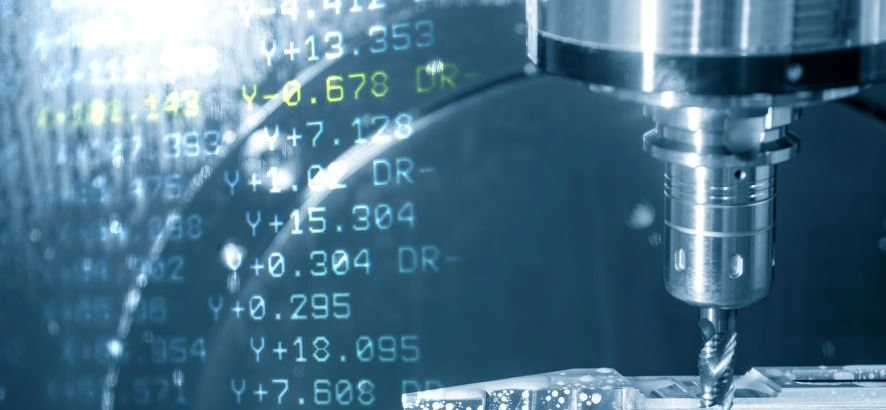
G-codes and M-codes are part of CNC lathe operation
Other Aspects of Effective CNC Lathe Utilization
To add to the CNC programming requirement, proper utilization of CLC lathe parts demands:
- The right setup and selection of cutting tools
- Using the right materials
- Using the right machining techniques
- Proper CNC lathe maintenance
What are the parts of a CNC lathe machine?
No matter how advanced a CNC lathe is, it features several main parts. Whether you are a parts producer or consumer, identifying these parts can add value to your operations.
For instance, it can help you know the qualities of a reputable CNC lathe parts producer. This way, you will not waste time sampling different manufacturers and getting disappointed in the process.
Prolean Tech delivers highly and matches that with results. You can expect us to manufacture parts as fast as within a day, cost-effectively, and to the highest dimensional accuracy.
Here are the different CNC lathe parts.
Machine Bed
The machine bed is also fundamental so it must be considered one of the most critical parts of a lathe diagram. It is the foundation upon which all the other CNC lathe components sit. Made from polymer concrete or cast iron, this component has all the characteristics to take large loads, impact or otherwise.
The CNC lathe machines at ProleanTech are powerfully and accurately built to not only absorb vibrations but also ensure consistent accuracy. If you are looking for the most accurate and relevant CNC machined components, you can rely on our advanced CNC lathe and highly experienced machinist to deliver.
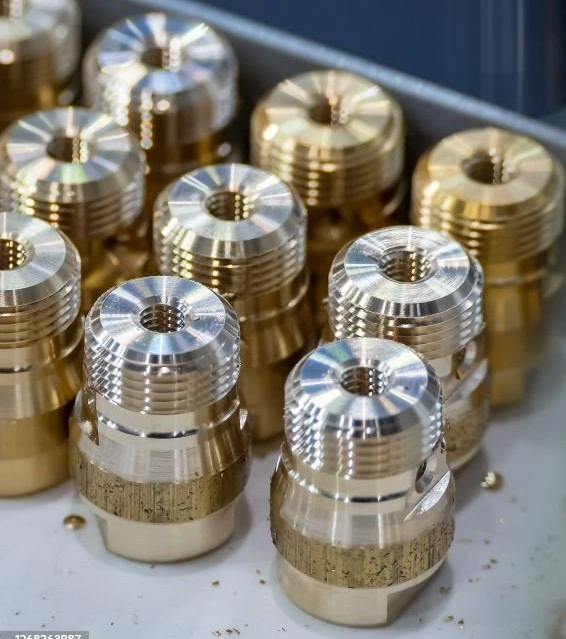
CNC-machined metal parts
Main Spindle
The main spindle is affixed to the headstock. The main function of the spindle is to rotate the workpiece. This CNC lathe part is driven by a powerful motor, which provides different speed options.
The main spindle comprises the spindle drive system and assembly. The performance of this CNC lathe part affects the machined part, so it is a central part of the lathe system.
Other components that interact directly with the spindle are gears and the chuck.
Chuck
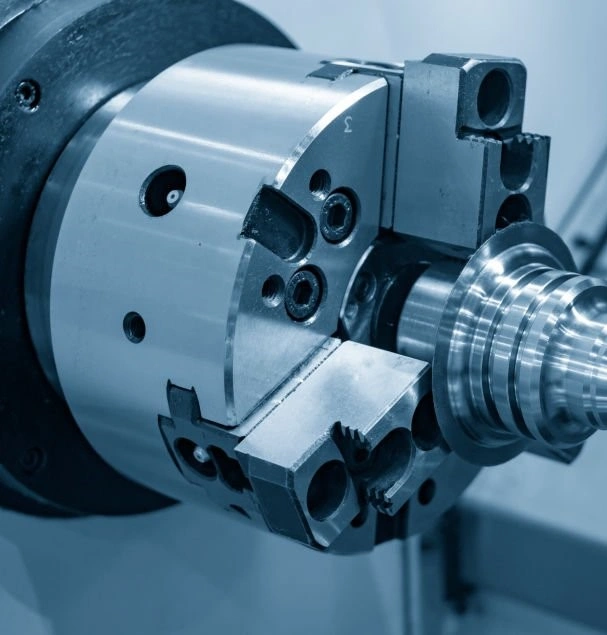
A CNC lathe chuck
The chuck is the work-holding CNC lathe part. Its main function is to hold the workpiece securely as it is machined. It is fixed to the main spindle, meaning it rotates at the speed of the main spindle.
The best CNC lathe machines come with versatile chuck designs that accommodate a wide range of workpiece sizes and shapes. There are different chuck designs including collet chucks and three-jaw chucks.
For even better machining results, consider machines with precise centering features and quick-changing mechanisms. You want a CNC lathe capable of holding the workpiece securely and accurately.
CNC Controller
Many term the CNC controller as the brain of the CNC lathe and there is justification for that. This CNC lathe part accepts the CNC program and executes it. Executing the program instructions means producing signals that the drive system of the CNC lathe can follow.
Specifically, the CNC controller interprets the M-code and G-code instructions, coordinates axis movement, and controls the cutting parameters. This is also the lathe part that provides the user with an interface to interact with the machine.
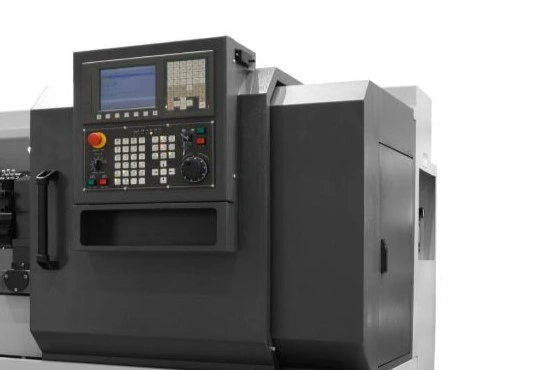
A CNC control panel
In modern CNC lathe machines, the CNC controller has advanced capabilities such as network connectivity and adaptive control.
Tool Turret
The tool turret is a special part of the CNC lathe that holds the tools. It rotates and indexes the tools as required by the machining operation. It is a perfect alternative to manual tool handling and, thus a valuable time saver in machining.
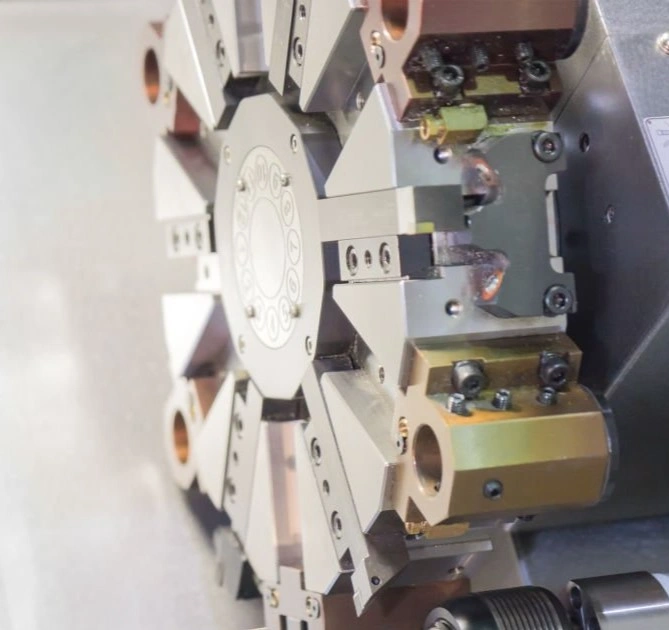
A Tool Turret
There are three main types of tool turrets namely Base Mount Turret, Verein Deutscher Ingenieure Turret, and Bolt-On Turret. These versions have different versatility, rigidity, tooling capacity, and cost-effectiveness.
Tool turrets are popular in precision machining for applications in energy, medical, automotive, and aerospace industries.
Carriage
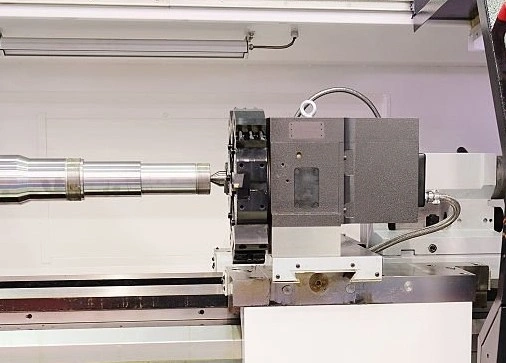
A carriage of a CNC lathe
While the tool turret holds and selects cutting tools, the carriage moves and positions the cutting tool. Typically, the carriage will have the tool turret mounted on it. The carriage is critical to the dimensional accuracy of the CNC machined components.
This CNC lathe part comprises linear guides for longitudinal movements and a cross slide to enable and smoothen the X-axis movements. It can accurately position itself thanks to the lead screws.
How to Upgrade CNC Lathe Parts
If you have been using your CNC lathe machine and parts for a considerable time, you may have noticed it falls short of requirements for accuracy, safety, and advanced solutions. Giving it an upgrade is a good idea, even if only to enhance its longevity.
You don’t have to worry about where to get CNC lathe parts for the upgrade, with Prolean Tech by your side. Partnering with us means an upgrade like no other in terms of methods used and the resulting CNC machining precision.
Our tolerances are down to ±0.0002″ (0.005mm), as can be attested by previous clients of CNC machining service such as BMW, Emerson, and Rockwell Automation.
You can get your quote now to kickstart your journey to more reliable CNC lathe parts.
Before jumping into it, ask yourself several questions:
Are the upgrades necessary?
The main reason for an upgrade of the CNC lathe is the need to keep up with the latest technology. It may also be necessary to enhance the accuracy and precision levels of the machine for acceptable performance.
What CNC lathe parts can be upgraded?
This is another fundamental question when considering a lathe machine upgrade. CNC lathe machine components that are most commonly upgraded are control panels, lead screws, and the CNC software. Upgrades bring benefits like enhanced speed, better control, and overall improved functionality.
In Conclusion
Understanding the different CNC lathe parts is the starting point to knowing the type and size of parts that a CNC machined parts provider is capable of delivering. It can also help you know how to manage your lathe machine and parts if you are using one already.
As highlighted here, the CNC lathe is a collection of parts that combine to manufacture most of the CNC turning parts we use in industries. We hope you will now have an easier time looking for CNC machine parts for your machine or products from the machine.
At ProleanTech, years of using advanced CNC lathe machines have exposed us to different projects and client requirements. No matter the part of a CNC machine you are looking for, we can always deliver.
If you have any questions about the product range or how to optimize your CNC lathe, contact us today.
FAQs
What is a CNC part?
A CNC part is any section or CNC lathe components that combine to enable the machine to function. Examples of CNC parts are tool turret, carriage, main spindle, and CNC controller.
What are the basic CNC components?
The basic CNC components are the main spindle, carriage, CNC controller, machine bed, and headstock.
How to work a CNC machine?
Here are the main steps to work a CNC machine:
-
Set up the CNC machine
-
Prepare the CNC program and load it
-
Set up the cutting tool and workpiece
-
Start the machining process
-
Remove and check the CNC machined part
-
Clear debris and clean the machine

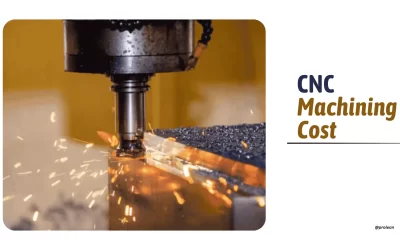
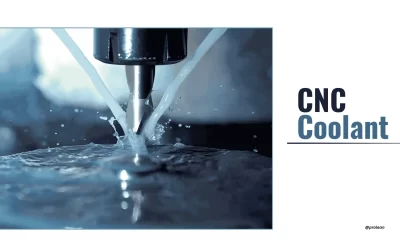
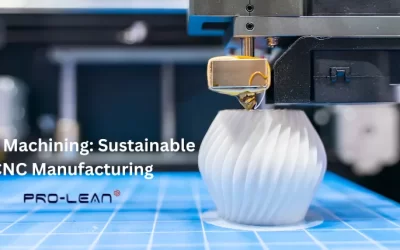
0 Comments